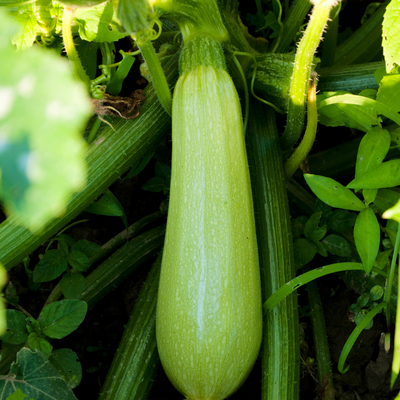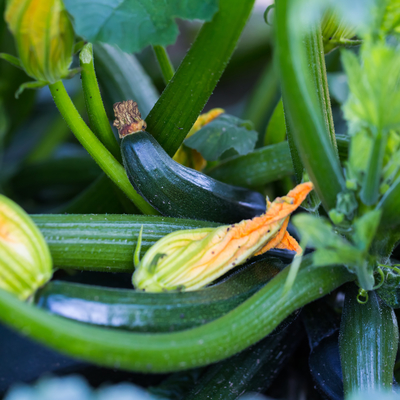A quick guide to summer squash and zucchini
- Some varieties form long, rambling vines.
- Bush types fit more easily into a small garden.
- Sow seed directly in the garden after the soil has warmed, in late May to early June.
- Plastic mulch and row covers allow earlier planting.
Warm weather vine crops
Summer squash (Cucurbita pepo), including zucchini, crookneck, straightneck, patty pan and other similar types, is common in Minnesota vegetable gardens. You can eat squash fruits cooked, raw, and shredded or grated in baked goods. Squash flowers are edible, as well.
Like other “vine crops,” summer squash plants grow best and produce the most fruit in warm weather. Some varieties form long vines. Others are bush types that fit more easily into a small garden.
Squash plants have separate male and female flowers. A slender stem attaches male flowers to the plant. Female flowers grow close to the main vine. Between the flower and the vine is a small round ovary, the unfertilized fruit.
An insect must move the pollen from the male flowers to the female flowers. Bees are common squash pollinators.
Soil pH and fertility
- Have your soil tested.
- Apply phosphorus (P) and potassium (K) according to soil test recommendations. Many Minnesota soils have enough phosphorus.
- Unless your soil test report specifically recommends additional phosphorus, use a low- or no-phosphorus fertilizer.
- For good yield and quality, the best soil pH range for vine crops is between 6.0 and 6.5, which is slightly acidic.
- Most gardeners, even those with neutral or slightly basic ("alkaline") soils, can successfully grow squash.
- The soil should be moisture retentive yet well drained.
- Forming raised beds will ensure good drainage, which these crops need.
- You can improve your soil by adding well-rotted manure or compost in spring or fall. Do not use fresh manure as it may contain harmful bacteria and may increase weed problems.
- If you use manure or compost, you may not need additional fertilizer applications, depending on how much organic matter you use.
- Side dress with fertilizer when the plants begin to spread out their vines, using one-half cup of 46-0-0, or one cup of 27-3-3, or 3-½ cups 10-3-1 for each 100 feet of row.
- Do not use “Weed and Feed” type fertilizers on vegetables. They contain weed killers that will kill vegetable plants.
Planting
Direct seeding is preferred for starting squash.
Squash seeds will not germinate in cold soil. Plants started indoors and set out into cold soil will also not grow very well. Squash plants started indoors also fail to grow in the garden because of damage during transplanting.
Use a soil thermometer and sow seeds after the last frost date, once soil temperatures are at least 70° F at the two-inch depth. In most of Minnesota, this will be sometime in late May, or early June in the north.
Some varieties of summer squash grow fruit over a longer season. Some grow many fruit within a shorter period. For a longer, more even harvest, seed only part of your squash garden at first, and then finish the planting three weeks later.
Sow seeds about a half-inch deep. For vining types that will spread out in the garden, sow their seeds two inches apart. Allow about two or three feet of space on either side of the row for the vines to spread.
After emergence, thin seedlings to stand eight to 12 inches apart. A “hill” of three or four seeds sown close together is another way to plant squash in the garden. Allow five to six feet between hills.
You can plant bush types, with very short vines, in closely spaced hills, or in closely spaced rows, with only two to three feet between rows or hills.
Earlier planting is possible with black plastic mulch, which raises soil temperature. If uncovered, the black color of the mulch will absorb heat from the sun and warm the soil faster.
Apply black mulch after you prepare the soil in spring. Cut holes or slits in the mulch, and plant the seeds as above. After the seedlings have emerged, position the row covers over the plants, securing the edges with soil or staples.
Spun row covers raise air temperature around the plants and protect them from cold nights. Row covers keep away both pests and beneficial insects required to pollinate the flowers, so you must remove them from the plants once flowering begins.
How to keep your summer squash and zucchini healthy and productive
- Long taproots and branching surface roots help squash plants to access soil moisture, even in dry weather.
- Squash plants are heavy water feeders, so you should make sure they have enough soil moisture. Always soak the soil thoroughly when watering.
- Vine crops need about one inch of water from rainfall or irrigation each week during the growing season.
- Water sandy soils more often, but with lower amounts applied at any one time.
- Drip hose, soaker hose or careful watering of the soil, so that the leaves stay dry, are ways to water these crops. Do not use a sprinkler or spray the plants with a hose.
- Plants that you have trellised to grow vertically may need watering more often.
- Frequent, shallow cultivation with a hoe or hand tool will kill weeds before they become a problem.
- Scratch the soil surface with a hoe just deeply enough to cut the weeds off below the surface of the soil. It is important not to cultivate too deeply or too close to the plants.
- Continue cultivating as long as you can do so without injuring the plants. This is usually when the vines begin to spread between the rows.
- When cultivation is no longer possible, pull large weeds by hand.
- If you use mulch such as straw or compost to help control weeds, do not apply it until the soil temperature is at least 75°F. These mulches can slow soil warming.
Harvest
- Pick summer squash when they reach the size you prefer, but before they are over-large, with large seeds, hard skins and fibrous or watery flesh.
- Tiny “baby” fruits are tenderer. If your squash planting is large, you may choose to pick some at the baby stage. In a smaller planting, it makes more sense to harvest medium-sized fruits.
- Squash blossoms are also edible, and you should harvest them the day they open. You can pick male flowers without hurting the yield of squash fruits.
- If you leave very large squash fruits on the vine, plant yield will decline, so remove fruits that have grown too large even if you will not use them.
- Harvest often, but be careful not to disturb the plants, as they often send out new roots from joints in the vine. Disturbing the vine can break these roots.
- Do not pick fruit when the vines are wet, because of the danger of spreading diseases.
Storage
- Pick and eat summer squash as it ripens.
- You can keep summer squash in the refrigerator for up to four days.
- The longer you store summer squash, the more likely the cold is to damage it. The summer squash will develop pitted skin and water-soaked flesh.
- You can freeze, pickle and can summer squash using a pressure canner.
Managing pests, diseases, and disorders
Many things can affect summer squash and zucchini crowns, leaves, flowers, and fruit. Changes in physical appearance and plant health can be caused by the environment, plant diseases, insects and wildlife. In order to address what you’re seeing, it is important to make a correct diagnosis.
You can find additional help identifying common pest problems. Ask a Master Gardener to share pictures and get input.
Even though you may see damage to some plants doesn’t mean all hope is lost. One plant can produce a lot of fruit, so your garden should be able to tolerate a little disease or insect feeding.
- Striped cucumber beetles damage plants by eating leaves as well as flowers, stems, and fruit.
- Spotted cucumber beetles migrate to Minnesota every year, and once here they feed on all above-ground parts of the plant.
- Squash vine borers burrow into the crowns of zucchini and summer squash, causing the entire plant to wilt.
- Squash bugs can often be found in large groups, and their feeding gives leaves a ragged appearance.
Many of the same cultural practices help prevent a wide variety of summer squash and zucchini diseases.
- Powdery mildew is a fungal disease that causes powdery white spots to form on leaves and vines.
- If new growth on the plant is off-color, twisted, or distorted, it could be a cucurbit virus.
- Anthracnose can cause large, tan spots on leaves.
- Angular leaf spot causes small, blocky spots on leaves, which are surrounded by a yellow halo.
- During wet periods, choanephora rot can infect blossoms, causing fruit to be mushy and covered in a fuzzy black growth.
- The first blossoms often drop from the vines. This is not a problem, since the first flowers to appear on the vines are male. The female flowers, which open later, have a swelling at the base that forms the fruit, also known as the ovary. After bees pollinate these female flowers, the fruit develops.
- It is also common that the first flush of fruit isn't adequately pollinated; time often solves this issue as bees find the planting.
- Poor fruit set could be due to not enough pollination. Cold, rainy or cloudy weather can reduce pollination.
- Tasteless fruit could be due to dark, cloudy weather or disease.
Reviewed in 2023



